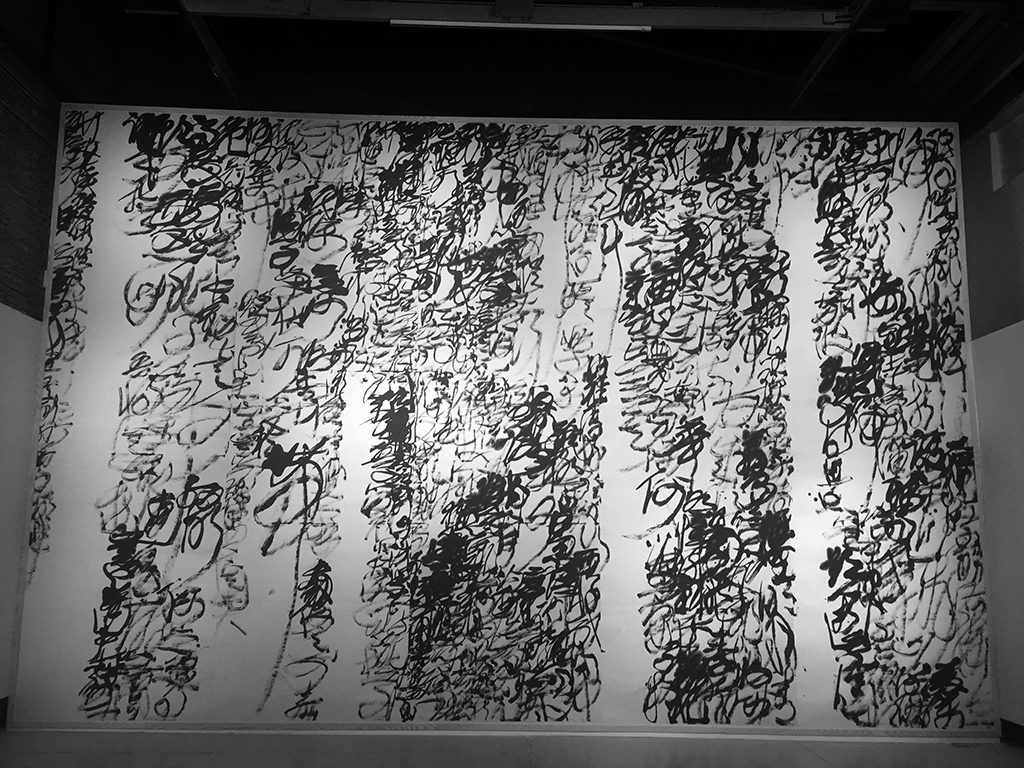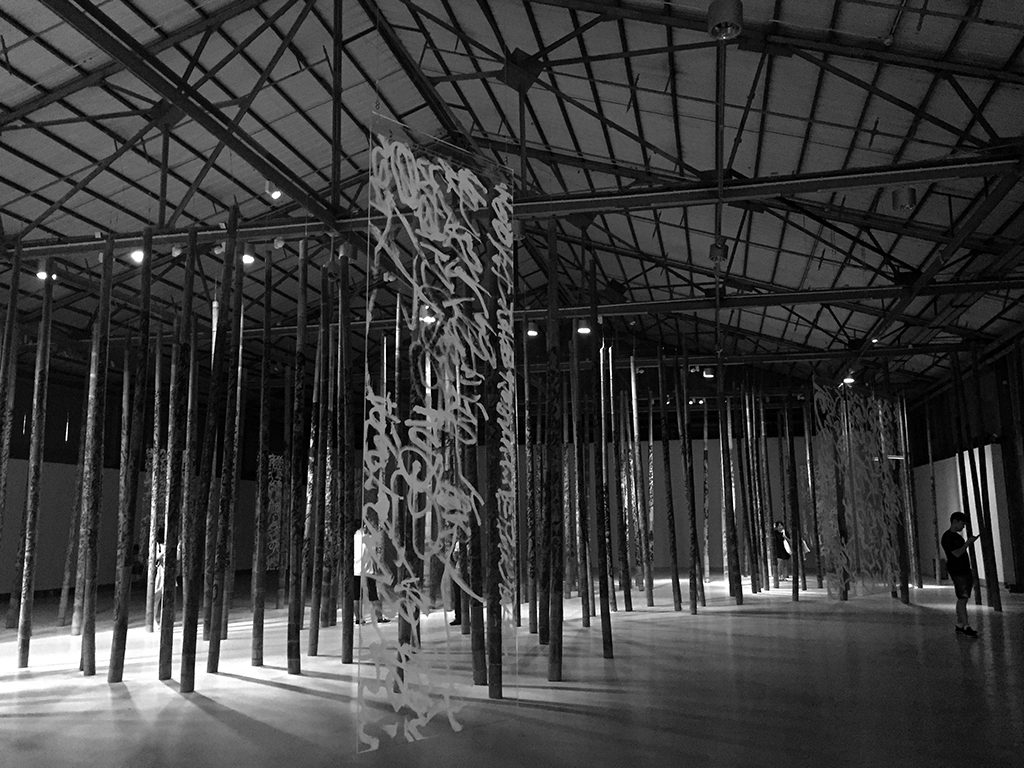World of Bamboo,
Source of Writing
Wang Dongling: The Bamboo Path
OCAT, Shenzhen
12.08.17 – 12.11.17
Translated by Duncan Hewitt
Hidden behind the bustling art market, outside the OCAT exhibition venue is a row of decorative thin bamboo plants, which creak in the wind. Thinking back to it now, they create a completely different atmosphere and vista to the hardy old giant mao bamboo inside the exhibition hall. The 201 trunks of mao bamboo do not create the impression I had expected, of a ‘forest of tall bamboo’, but rather conjure up the sense of a winding path leading to a secluded spot. The green bamboo stems are spread through the regular space of exhibition hall A, spaced out and arranged as though still growing in the original forest from which they came. In the front section of the space, two little paths leading to the centre of the bamboo grove have been laid out. They lead visitors towards a ‘clearing’ in the forest, where they can stop and look up, and attempt to decipher the odes to bamboo and other similar poems written on the trunks in the work Chaos Script.
Wang Dongling’s ‘chaos script’ is not really chaotic; it is ‘apparently chaotic but actually controlled’, going beyond the traditional rules for writing calligraphy.1 Its legibility is reduced to a minimum, and after being internalised in the observer’s mind, it produces the effect of elongated, uninterrupted lines. The artist, who has constantly broken new ground in his calligraphic experiments, has long defined his calligraphy as contemporary art, and the abstract calligraphic works on the walls on two sides of exhibition hall B demonstrate his experimental approach and mood, where the lines and the black ink intermingle, and the words and images merge with each other. After passing more than a hundred small square elements of calligraphy, we come upon a huge piece of ‘chaos script’, which fills the whole surface of a wall, and consists of poems by Ji Kang and Ruan Ji, two of the ‘sages of the bamboo grove’. Here, characters sometimes overlap with other characters, lines with other lines, the brushstrokes piled on top of each other, the real and the imaginary combining with each other, to create an overarching visual effect, independent from the content. The convention of leaving a blank border around the work has also been dispensed with. Calligraphy has turned into a very relaxed type of abstract painting, becoming purer in the process.
The day I went to see the exhibition happened to be a leisurely Saturday afternoon. There were only four or five people there. Some were moving in and out of the bamboo stems, taking photos, or standing behind the thick bamboo trunks. People who had given up reading poems would walk a little, then stop again, so enchanted that they were unwilling to leave. Under the dim flickering rays of light, the bamboo seemed to be suspended in the air; it stood only lightly on the ground, its insubstantiality reminiscent of a forest swaying in the wind. Outside my line of vision the traces of the painstakingly applied ink gradually merged with the green bamboo; this variegated state conveyed a hint of the shape of the bamboo’s leaves. Traces of ink seemed to float out from the surface of the bamboo and merge with the ‘chaos script’ on the acrylic boards, filling the centre of the space. For a moment, real time seemed to stand still, while memories of the ancients came flooding into my mind.
See those secret inlets of the Qi,
where green bamboo is flourishing.
See those secret inlets of the Qi,
where green bamboo gives cover.
See those secret inlets of the Qi,
where green bamboo grows dense.2
The green bamboo grove, the dancing traces of ink, the white characters embedded in the space: amid the rhythmic poetry and words, people find themselves in a giant sensory space, wallowing in a man-made contemporary bamboo grove of words.
Last year and the year before, the Heart Sutra exhibition of chaos script at the Brooklyn Museum and the Imperial Ancestral Temple in Beijing brought the process of writing calligraphy into a public space: the calligrapher wore red shoes and socks, created his works ‘live’ on a huge canvas, on watercolour paper and on the floor, and the process of writing took place as the audience looked on. And The Bamboo Path has ‘symbolically privatised’ this kind of empty, neutral public space.3 The opening ceremony retained a performance element, but the entire exhibition hall was turned into an installation, inviting the audience to come in and experience the whole space, which took the form of a single work. The meandering path, the floating acrylic boards, the dim lighting, the calligraphy, even the presence of the visitors, all became part of the installation. On each bamboo trunk there was an individual section of poetry, such as a selection from the Book of Songs, or Su Shi’s famous line: ‘I can go without meat in my meal, yet I can’t live in a place without bamboo.’ Yet, in this space, the meaning of any poetic writing gradually became secondary. Here the vehicle for displaying calligraphy was no longer simply separate, individual works, but the space itself: the curator and the calligrapher had created a realm for walking, for looking, for wandering. As visitors walked along the bamboo path and gazed at the chaos script, they might find themselves happily enveloped in the peaceful mood of the bamboo grove, or discover, to their surprise and delight, the only legible poem among the chaos script: Lu Zhaolin’s ‘The Bamboo beside the Steps’ was written in the simple, classic calligraphic style of Han dynasty bamboo slips, enabling people’s memories to leap between ancient and modern times. In such an environment, the collision of bamboo and writing in connection with history and origins was inspiring.
Ever since the fourth century, when paper copying books became the main and most convenient medium for writing, we have used ink wash on paper. In The Bamboo Path, however, Wang Dongling’s writing flees from the calligraphic achievements of ink wash on paper, and returns to the ancient stylistic approach. Writing about bamboo, on bamboo, evokes the pure, classical ambiance of Qin and Han dynasty bamboo slips, as well as the kind of mental image – dating back to the Seven Sages of the Bamboo Grove – that bamboo evokes for Chinese people. And the territory of The Bamboo Path does not end there. When paper is replaced by natural bamboo stems, the more adhesive nie you ( literally, ‘pinch oil’, a thick coal-and-salt-based ink used for writing on bamboo in Anji, Zhejiang province ) is used as the ink. The curved surface of the bamboo trunks shatters the limitations of two-dimensional writing on a flat surface – the ‘chaos script’ goes right round the bamboo, covering all its sides. In this space, the order, continuity and direction of an overall image, traditionally made up of overlapping, interrupted and bifurcated lines, are completely superseded. The dry, thick nature of the nie you means that when it is used to write on the uneven bamboo trunks, it forms a thick grain and texture,4and requires a brand-new touch and perception – ‘using the wrist’s strength, and relying on the marks made by the brush when the ink runs out’.5 This displays both uninhibited adjustments to the style of writing and the strength of the calligrapher.
The chaos script on the bamboo consists of odes to bamboo written by successive generations, selected for their aesthetic interest. But once we have been led into this bamboo grove, the inner meaning and images associated with these words are abandoned somewhere in the recesses of our minds. The heavy, time-worn brushstrokes demonstrate an integral rhythm, between image and abstraction. From the overall visual effect of the lines, to the shift from a two-dimensional flat surface to a curved surface and three-dimensional space, calligraphy has again stripped off a layer of clothing that had been ossified by models of creation and exhibition, and has launched an assault on people’s experience of how to understand it. Reading has vanished, paper has also vanished – calligraphy has broken away from all kinds of historical and cultural connotations and the media associated with them. The chaos script in The Bamboo Path unearths a contemporary vitality from a forgotten culture long buried in the mists of time; from rules to no rules, people’s existence is demonstrated by the heart and hand working as one, the spirit and the rhythm being closely linked. What you write, what you write it with, are no longer important, because what you write is all about human spirit and emotions, and the natural instincts of the soul. And calligraphy is close to the earliest spirit of writing: calligraphy was originally a depiction made by a writer using lines, which embodied and expressed people’s consciousness and existence.
During this short journey of just twenty or thirty metres, the bamboo grove does not provoke any very startling sense of really being in such a place. The little path is merely a hint, its sense vague and indistinct – but the origins of calligraphy come flooding out from within it.
1. Wang Dongling, Iuanshu Chaos Script, Ink Studio, Beijing, 2016, p. 20.
2. Qi Ao, ‘Secrets of the Qi’, in Book of Songs: Airs of the States, Airs of the Wei, trans. Michael Farman <http://www.asiancha.com/content/view/1617/110/>.
3. Boris Groys, ‘Politics of Installation’, E-flux Journal, vol. 2 ( January 2009 ) <http://www.e-flux.com/journal/02/68504/politics-of-installation/>.
4. Wu Hung, Wang Dongling, ‘Bamboo Path’, The Art Newspaper, 2017.
5. Wang Dongling, ‘Writing On Bamboo’, The Art Newspaper, 2017.
竹之境,书之源
《王冬龄:竹径》
OCAT 当代艺术中心,深圳
2017 年8 月12 日 – 2017 年11 月12 日
隐匿在熙熙攘攘的艺术集市后,OCAT 场馆外种着一排装饰性的吟风细竹,回忆起来,与展厅内苍劲的毛竹形成了截然不同的环境和意境,201 根毛竹并没有如想象般的形成“茂林修竹”之景, 却有一番通幽曲径的意味。青竹散置于 A 展厅规整的空间中,依照原生竹林的真实间距和状态而“生长”,空间前端有意排列出两条小径,通往竹林中央,引导观者向前来到林间空地,驻足仰望, 试图识读青竹上咏竹诗和题画竹诗的“乱书”。

Wang Dongling: The Bamboo Path, installation view, exhibition hall B, OCAT, Shenzhen, 2017. Photo: Tang Kexing
王冬龄的“乱书”并不是真的乱,是“乱然后治”,超越传统的书写法则1,文字的识读性降到最低,自然透过人的意识内化为悠长连绵的线条中。在书法实验中不断探寻的王冬龄早已把自己的书法定位为当代艺术,B 展厅两侧墙面的抽象书法创作显示了他的实验性和趣味,线条与水墨混合,文字与图形相配。顺着百余幅斗方小稿,我们看到了覆盖整个墙面的巨幅乱书,书写着竹林贤士嵇康和阮籍的诗。字与字, 行与行之间时而交叉,笔画纷繁叠置,画面虚实相生,形成独立于内容的视觉形式整体,打破四周留空的一般作品形式,书法成了富有张弛的抽象绘画,变得更加纯粹。
去看展的时候恰巧是清闲的下午,只有三五人群或于竹间穿梭, 拍照,或藏于粗壮的竹子之后,放弃了读诗的人走走停停,
流连于其间的迂回。幽暗婆娑的光线下,竹子悬挂于空中,轻立于地面,不稳定的状态恰如临风摇曳的林间。捏油劲道的痕迹在视线之外逐渐与青竹融为一体,斑驳之状隐约显现出竹叶之形, 墨迹从竹面上浮出,连同透明亚克力板上的乱书弥漫在整个空间当中,霎时真实时间凝固,获得了古人的记忆。
瞻彼淇奥,绿竹猗猗。
瞻彼淇奥,绿竹青青。
瞻彼淇奥,绿竹如箦。2
青色的竹林,舞动的墨迹,嵌入空间的钛白字体,在韵律般的诗文中,人们置身于巨大的感知空间,浸淫在人造的当代文字竹林中。
前年和去年在布鲁克林博物馆和北京太庙前乱书的《心经》将书写过程放入公共空间,书法家穿着红袜红鞋,在巨幅画布, 水彩纸或地面上的现场创作,书写过程与人们的观看同时发生。而“竹径”却将这种空无, 中立的公共空间“象征性的私有化”3 了, 开幕式保留了表演性的环节,而整个展厅却是一个完整的装置空间,邀请观众进来体验以单件作品形式存在的整体的空间。蜿蜒的竹径, 漂浮的亚克力板, 幽暗的灯光, 书法,甚至是游人的状态, 都成为装置的一部分。每一根毛竹上都是独立的诗篇,如《诗经》, 如苏轼的名篇“宁可食无肉,不可居无竹”,但在这个空间中,任何诗文的意义被逐渐推远。书法的呈现不再以单件独立的作品为媒介,而转变为空间本身,策展人和书法家创造了一个可行, 可望, 可游之境,人们沿着竹径观赏到这些乱书,也许会沉浸于竹林中的畅叙幽情,也许会惊喜地发现唯一一篇可以辨认的诗文,乱书丛中,卢照邻的《阶竹》古朴的汉简风格让人们记忆穿越古今。恰恰是在这个环境中,“竹”和“书”关于历史和渊源的碰撞令人为之一振。

Wang Dongling: The Bamboo Path, installation view, exhibition hall A, OCAT, Shenzhen, 2017. Photo: Tang Kexing.
自4 世纪纸抄本成为方便的主要书写载体后,纸墨沿用至今, 而王冬龄的竹径之书逃离了书法的纸墨成就,回归到古老的形式: 竹上书竹唤起秦汉竹简的古拙之感和竹子对于中国人的竹林七贤式的精神意象。而“竹径”之境并不仅仅止于此,纸被原生态的竹身替代,墨是更有附着力的捏油;竹竿的弧面打破了平面书写的局限,乱书四面立体环绕呈现,本就交织, 间断, 分叉的线条组成的整体图像,在这个空间中,被完全打破了顺序, 连续和方向; 捏油的干涩和浓稠在不平滑的竹竿上书写,形成“黑离离”4 的质地和肌理,需要“重力用腕,无墨求笔” 5 的全新触觉和感知,呈现出放荡不羁的笔法变化和书写者的力量。
竹上的乱书皆为依据审美趣味而甄选出来的历代咏竹诗词, 但文字所附加的含义和意象, 在人们被引入这片竹林空间后,被遗落在感知深处,厚重和沧桑的笔墨线条在意象与抽象之中展现出浑然一体的韵律。从线条的整体视觉,到从二维平面移入弧面及三维空间,书法再次脱去一层被创作和展示模式禁锢的外衣, 冲击着人们对其认知的经验,阅读消失了,纸墨也消失了,超脱种种历史和文化涵义以及附属媒介,竹径中的乱书发掘出隐没在久远而被遗忘的文化中的当代活力,从有法到无法,人的存在体现为心手相应, 气韵相连,写了什么,用何而写,不再重要,因为书写的都是人的精神情感和心灵的自然而然,书法更靠近最原初的书写状态——书法本是书写者通过线条的刻划,寄托和表达人的意识和存在。
在二三十米短短的行走中,这片竹林并没有过多地唤起身临其境的震撼,小径只是点到为止,感知是模糊和隐约的,而书法的本源倾流而出。